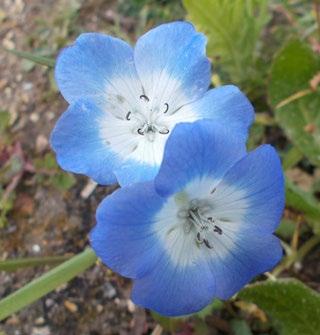
16 minute read
Compiled by Matthew Berry
ADVENTIVES AND ALIENS
Adventives and Aliens News 24
Advertisement
Compiled by Matthew Berry
Flat 2, Lascelles Mansions, 8–10 Lascelles Terrace, Eastbourne BN21 4BJ
m.berry15100@btinternet.com
If I pick out a few records from what follows, it is by way of an introduction and should not be seen to detract in any way from the other records, all of which have their particular interest and importance. Nevertheless, I trust members will be fascinated to read about the occurrence of two unfamiliar Himalayan species, one woody and one herbaceous, which have been found in ‘wild’ situations, both in Scottish vice-counties (see v.cc. 96 & 104); and a S. African grass seen flowering remarkably early in the year in v.cc. 17 and 21, and with which we might like to familiarise ourselves in case it becomes more widespread. I have also included some more of Paul Stanley’s remarkable alien finds from the farmed landscapes of v.c.10. Many thanks.
V.c.4 (N. Devon)
Verbena incompta P.W. Michael (Purpletop Vervain). Northam (SS4500227855), 4/1/2021, R.I. Kirby: one c.2m tall plant growing at side of green track, Hanson Park. The first county record. See v.c.15.
V.c.9 (Dorset)
Nemophila menziesii (Baby-blue-eyes). Swanage (SZ0210879409), 1/5/2021, D. Leadbetter: three plants on verge south of sewage works, likely where soil had been imported the previous year. See Adventives & Aliens News 21, v.c.14.
Collinsia heterophylla Buist ex Graham (Chinesehouses). Swanage (SZ0210779409), 16/5/2021, D. Leadbetter: a number of plants on verge south of sewage works. At a somewhat later date 20 plants were seen in flower (D. Leadbetter pers. comm.). An annual (Plantaginaceae) native to California sometimes grown as a garden plant. The twolipped flowers have an unusual structure with a

Nemophila menziesii (left) and Collinsia heterophylla (right), Swanage, Dorset (v.c. 9). David Leadbetter
short asymmetrical (dorsally inflated) corolla tube, two white upper corolla lobes and two purple lower corolla lobes, the latter concealing a third yellow central lobe which is longitudinally folded and encloses the stamens and style. The synonym C. bicolor Benth. dwelt on the plant’s bicolorous flowers rather than its heterophylly, with the lower leaves being more stalked, toothed and/or lobed than the middle and upper ones. A v.c.13 record from 2002 was associated with a wild flower seed mix, BSBI News 96, pp. 44–46.
V.c.10 (Isle of Wight)
Lathyrus sativus (Indian Pea). Swainston (SZ458881), 8/9/2020, P. Stanley (conf. E.J. Clement): one blueflowered plant in a crop of Trifolium alexandrinum (Egyptian Clover), Great Park. The only v.c.10 record in the DDb. A glabrous annual native to the Mediterranean region. Even without flowers, the leaves of one pair of narrowly elliptic, grey-green leaflets are quite distinctive. See Adventives & Aliens News 10, v.c. 2. Stace (2019): 174.
Trifolium echinatum (Hedgehog Clover). Swainston (SZ458881), 8/9/2020, P. Stanley (conf. E.J. Clement): a few plants in T. alexandrinum crop, Great Park. There are only two other post-2000 records in the DDb, both for v.c.59 and perhaps for the same site. There are only 23 records in total. An annual native to south-east Europe and south-west Asia, known in this country as a wool and bird-seed alien. Stace (2019): 189.
Malva multiflora (Smaller Tree-mallow) (det. E.J. Clement), Malva parviflora (Least Mallow) (conf. E.J. Clement), Malva pusilla (Small Mallow) (conf. E.J. Clement), Havenstreet (SZ559881), 11/8/2020, P. Stanley: numerous plants of all three species growing with six plants of Oxybasis urbica (Upright Goosefoot) on dung heaps on the site of old chicken sheds, Little Duxmore Farm. All three are rather similar to other more frequently occurring Malva species and could be overlooked. The nutlet characters used in the keys seem to work most reliably on dried material. Stace (2019): 401, 403.
V.c.11 (S. Hants)
Galium murale (Small Goosegrass). Priddy’s Hard (SU613015), 8/1/2021; Leonard Road/George Street (SU612002), 16/1/2021; Alexandra Street (SU604005), 15/4/2021; Hill Park Road/Park Close (SU596005), 23/5/2021, J. Norton & D. Allan (also the recorders for preceding sites): all for Gosport with plants growing in pavements, cracks in tarmac roads and concrete, as well as bare soil along the edge of a grass verge. It was found new to v.c.11 by Paul Stanley in 2017 at two sites in Portsmouth (SU637048, SZ630997), where it is presumably extant. It was then recorded from an industrial estate in Chandlers Ford in 2019 by Martin Rand (SU426200), growing on a disturbed road verge. There have also been two further Portsmouth records, on a beach at Whale Island (SU641022, 27/8/2020) and at Esplanade Gardens
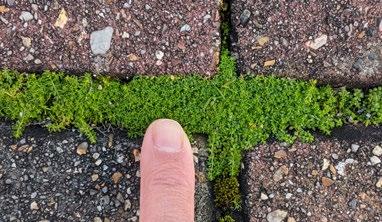
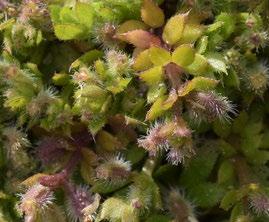
Galium murale, Gosport, S. Hants (v.c. 11); young plants in block paving, Priddy’s Hard, 8 January 2021 (left); flowering and fruiting plants, Alexandra Street, 15 April 2021 (right). John Norton
(SZ672988, 2/2/2021), Eastney, both found by R. Wardell. For details of records from other v.cc. up to September 2017, see BSBI News 136, pp.59–60. There are now c.50 records in the DDb. The small size and unobtrusive habit probably mean the full extent of its recent spread is under-appreciated. Stace (2019): 574.
Nerine bowdenii (Bowden Lily). Hayling Island (SU711002), 18/10/2020, R. Wardell: by the Hayling Billy Line. A bulbous S. African perennial (Amaryllidaceae) with pink flowers (c.8cm long) in a terminal umbel and the stamens and style obviously deflexed (vs not so in N. sarniensis). Much grown in gardens, it very rarely escapes or survives as a discard. New to v.c. Stace (2019): 942.
V.c.12 (N. Hants)
Armeria maritima subsp. elongata (Thrift). Aldershot (SU85165040), 28/5/2020, F.J. Rumsey (comm. A. Mundell): in pavement of Pavilion Road, seeddispersed from garden. This is better known as a native taxon of very restricted distribution. It is distinguished from subsp. maritima by the glabrous stem, longer bract sheath and the outer bracts being of equal or greater length than the inner. Stace (2019): 461.
V.c.14 (E. Sussex)
Cotinus coggygria (Smoke-tree). Lewes (TQ40E), 29/4/2020, P. Harmes: numerous seedlings along path edge, The Convent Field and Priory Mound. A native (Anacardiaceae) of southern Europe, this is very familiar as a planted shrub but far less so as a self-sown/regenerating alien. Stace (2019): 393.
Rumex scutatus (French Sorrel). Brighton (TQ321056), 21/8/2018, A. Spiers: two plants at base of wall at the corner of Pevensey Road and Hastings Road. It has leaves that are petiolate and almost as wide as long, otherwise it resembles R. acetosa (Common Sorrel). There have been very few Sussex records. A perennial (Polygonaceae) native to central and southern Europe, west Asia and north Africa. Its native habitats are rocky places, including cliffs, so it is hardly surprising that so many British records should be associated with walls. Its occurrence in new sites must partly reflect the waxing and waning of its popularity as a culinary herb. It was known for several centuries at Craigmillar Castle in Edinburgh (v.c.83), Clement & Foster (1994) – the most recent record of it there in the DDb being from 1955. Stace (2019): 475.
Ipomoea purpurea (Common Morning-glory). Eastbourne (TV6159898938), 24/6/2021, M. Berry (conf. E.J. Clement): one plant at base of steps and another at base of adjacent wall, building at west end (north side) of Elms Avenue. A climbing annual (Convolvulaceae), native to N. America, it has been in wool, bird-seed and soya bean waste. It is also certainly a garden plant. The individual flowers last for less than a day, thus the English name. The first Sussex record of this or any other Ipomoea species. Clement et al. (2005): 224. Stace (2019): 603.
Carthamus tinctorius (Safflower). Polegate (TQ5773705117, TQ5774104930), 26/6/2021, M. Berry: two plants on imported soil, south verge of Polegate By-pass. The plant at the first grid reference was close to var. inermis. An annual (Asteraceae) from south-west Asia and a classic bird-seed alien of tips and waste places. It has also lately been in some wild flower seed mixes. A number of the more recent v.c.14 records have been from the Brighton area. Clement et al. (2005): 298. Stace (2019): 737.
V.c.15 (E. Kent)
Verbena incompta P.W. Michael (Purpletop Vervain). Near Oare (TR00466422), 4/9/2019, L. Rooney & D. Chesterman: two plants at a disused gravel pit, with V. bonariensis (Argentine Vervain). Its source here is unknown. For an account of the taxonomic history and present European status of this S. American native (Verbenaceae), see p. 25 of Kent Botany 2019, where there is a key separating it from the closely related V. brasiliensis Vell. (Brazillian Vervain) and V. bonariensis (taken from a referenced 2011 paper by F. Verloove), and with photos of the Oare plants on p. 26. It might be overlooked elsewhere as V. bonariensis, from which it basically differs in having smaller corollas and longer, narrower inflorescence spikes. The first record for v.c.15 and for the county.
Avena barbata (Slender Oat). East of Boughton (TR0956158688 to TR0961458675), 7/12/2019, L. Rooney: in large quantity on verge and hedge line of the coast-bound carriageway of the A2, first noticed but not confirmed in July. The first v.c.15 record and for Kent as a whole. See pp. 10–11 of Kent Botany 2019. It is described in Ryves et al. (1996) as ‘a wool and grain alien; established in the Channel Islands’, and in Stace (2019) as a ‘rare grain-alien’, ‘naturalised in Guernsey since 1970’; it might be increasing with recent single records from v.cc.54 (2010) and 57 (2020), and three from v.c.6 (2015 and 2017) – all from habitats such as arable fields and road verges. Stace (2019): 1065.
V.c.17 (Surrey)
Corydalis cheilanthifolia (Fern-leaved Corydalis). North Sheen (TQ19507498), 14/7/2017, C.M. Bateman & G. Hounsome: several plants self-sown on the boundary wall of a house at the junction with Sheen Common Drive, Orchard Rise. A rhizomatous garden plant (Papaveraceae), native to China, with pale yellow flowers in racemes and fern-like leaves. In the garden it is a species that does well in damp, shaded situations. Stace (2019): 98.
Potentilla inclinata (Grey Cinquefoil). Witley (SU94583973), 13/6/2017, E.J. Clement & G. Hounsome: one plant by path in churchyard. A perennial garden plant (Rosaceae) from Eurasia, which can persist as an escape. I am not sure enough is made of the often bolt upright habit of this species in the various keys and descriptions. Clement et al. (2005): 153. Stace (2019): 271.
Thladiantha dubia Bunge (Manchu Tubergourd). Kingston (TQ1815070500), 19/4/2018, M. Christenhusz (conf. M.J. Crawley): in ‘suburbia’, but status uncertain. An east Asian native (Cucurbitaceae) which seems to be commercially available as a garden curiosity. This predates the Newhaven (v.c.14) record by some months. See BSBI News 141, pp. 47–50.
Ehrharta erecta Lam. (Panic Veldtgrass). Wimbledon (TQ24177097), 23/3/2021, P.M. Maculan (conf. M.A. Spencer & E.J. Clement): established and flowering well along road side retaining wall,
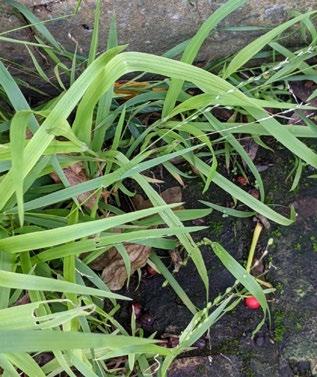
Ehrharta erecta, Kensal Town, Middlesex (v.c. 21). Mario Maculan
Wimbledon Hill Road. The first county record. A decumbent, tuft-forming perennial S. African grass known in this country as a wool and possible container alien. The panicle branches are often ascending or even appressed to the axis giving the inflorescence an almost linear appearance. The spikelets arise singly, they are oblong, laterally compressed, c.4–6mm long, with three florets (the lower two sterile) and slightly unequal, persistent glumes which are shorter than the florets. The leaf blades are 4–20 × c.1.5cm. The leaf sheaths have sickle-shaped auricles and the membranous ligule (2–7mm long) can be lacerate or entire, truncate or obtuse. It is an invasive introduction in N. America, Australasia and southern Europe. There have also been recent records in v.cc.25 (2016 and 2019), H21 (2017) and 113 (2019). BSBI News 60, pp.38–40, where it is also fully illustrated. See v.c.21.
V.c.21 (Middlesex)
Ehrharta erecta Lam. (Panic Veldtgrass). Kensal Town (TQ24648208), 9/1/2021, P.M. Maculan (conf. M.A. Spencer & E.J. Clement): well established along wall close to Grand Union Canal, ‘possibly
a bird-seed escape’. The first v.c. record. The early (January) flowering of the species in this country is not without precedent. It once flowered throughout the year in an unheated greenhouse in Kingston (v.c.17), where it had ‘seeded and persisted in quantity for over 20 years’, Ryves et al. (1996).
V.c.27 (E. Norfolk)
Urtica membranacea (Mediterranean Nettle). Caisteron-Sea (TG52591205, TG52581205), 24/3/2021, J.M. Parmenter & R.M. Leaney: c.20 plants in a suburban area between pavement and a cottage wall and to the side of the same building. The first Norfolk record. Stace (2019): 305.
Cotula australis (Annual Buttonweed). Rollesby (TG45461577, TG45501578), 27/2/2021, J.M. Parmenter & R.M. Leaney: two suburban populations growing in road gutters – the recorders’ inquiries traced the source to a caravan park in Skegness, where a local caravan owner had holidayed not long before; Caister-on-Sea (TG523118, TG52601205), 2021, J.M. Parmenter & R.M. Leaney: two further suburban populations in a pavement crack and consolidated gravel of a driveway, respectively. Clement et al. (2005): 334. Stace (2019): 799.
Gaillardia × grandiflora (Blanketflower). Sheringham (TG1668743189), 3/1/2021, S. Pryce (det. M. Ghullam): one plant in pavement crack outside garden where its parent was growing, west side and north end of Lawson Way close to Beeston Bump. The first Norfolk record and found during a New Year Plant Hunt. See Adventives & Aliens News 7, v.c.15. Clement et al. (2005): 364. Stace (2019): 821.
V.c.31 (Hunts)
Polypogon maritimus (Southern Beard-grass). Fletton (TL197978), 24/6/2015, S. Lambert & P. Kirby (det. S. Lambert): many thousands of plants on site of former Peterborough East Station. A wool and grain alien native to the Mediterranean and southwest Asia. There are six other records in the DDb, five post-2000. See Fig. 29, Ryves et al. (1996), for diagnostic drawings of Polypogon spikelets, including P. maritimus. Stace (2019): 1081.

Saxifraga cuneifolia, Blacko, South Lancashire (v.c. 59). Howard Beck

Geranium × oxonianum f. thurstonianum, Nelson, South Lancashire (v.c. 59). Howard Beck
V.c.44 (Carms)
Salvia hispanica L. (Chia). Llanelli (SN50), 2020, I. Morgan (comm. S. Tyler): large non-flowering population, junction of boundary wall and pavement near supermarket. It seems to be the first Welsh record. Ian Morgan grew on a cutting which flowered in December 2020, thus allowing
confirmation of the plant’s identity. See Adventives & Aliens News 23, v.c.3.
V.c.59 (S. Lancs)
Saxifraga cuneifolia (Lesser Londonpride). Blacko (SD8598541219), 11/5/2020, H.M. Beck (comm. H.M. Beck): on a dry-stone wall by a lane. There are six other v.c.59 records in the DDb. In addition to those given in Stace (2019), other distinctive features include yellow spots on the petals and leaves with a narrow translucent margin and rose-violet underside. Stace (2019): 139.
Geranium × oxonianum f. thurstonianum (Turrill) Mike L. Grant (Thurston’s Crane’s-bill). Nelson (SD8671938737), 21/6/2020, H.M. Beck (comm. H.M. Beck): large colony on an overgrown verge, Lee Road. It can be distinguished from the ‘standard’ plant by the narrower, darker pink petals. There is one other v.c.59 record in the DDb for 25/7/2020.
Chaenorhinum origanifolium (Malling Toadflax). Nelson (SD8697338613, SD8697738610), 21/6/2020, H.M. Beck (conf. D. Earle/comm. H.M. Beck): on outhouse roof and outer face of a nearby back yard wall. The second v.c. record. See Adventives & Aliens News 22, v.c.55.
Linaria maroccana (Annual Toadflax). Pendle (SD8671138743), 21/6/2020, H.M. Beck (conf. D. Earle/comm. H.M. Beck): two plants on an overgrown trackside verge, Lee Road. Clement et al. (2005): 249. There are eight other v.c.59 records in the DDb, the earliest from 1964; three refer to deliberate introductions. Stace (2019): 630.
V.c.63 (S.W. Yorks)
Petrosedum rupestre ‘Angelina’ (Reflexed Stonecrop). Methley Lanes (SE3624325460), 8/9/2020, D.A. Broughton: in derelict area of hardstanding with lots of other garden escapes. A cultivar with golden yellow leaves. See https://botanyhuntsyorks.blogspot. com/2020/09/petrosedum-rupestre-angelina.html.
Medicago arabica ‘Early Giant’ (Spotted Medick). Royds Green (SE3462726988, SE3466327086),
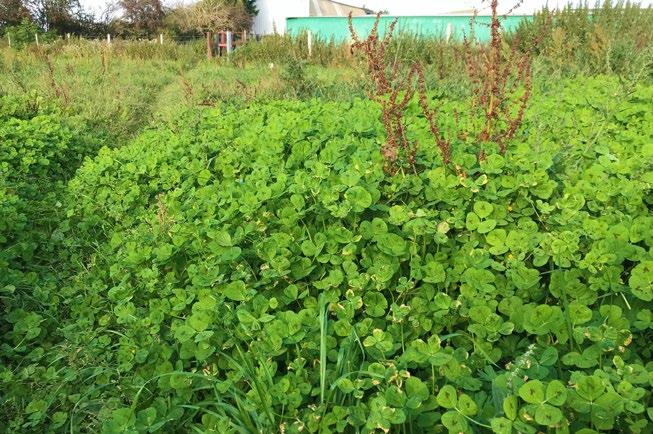
Medicago arabica ‘Early Giant’, Royds Green, S.W. Yorkshire (v.c. 63). David Broughton
20/9/2020, D.A. Broughton: abundant in horse paddocks and at track edges, St. Swithens Farm (on or close to Leeds County Way). A giant, early flowering fodder form for which there seems to be scant information generally and little or no distributional data in particular. See https:// botanyhuntsyorks.blogspot.com/2020/09/giant-spottedmedick.html for a brief description of how David Broughton arrived at the cultivar name. See v.c.64.
V.c.64 (M.W. Yorks)
Medicago arabica ‘Early Giant’ (Spotted Medick). Swillington Park (SE38652929), 6/4/2019, D.A. Broughton: on or near the Leeds County Way, colonising naturally from St. Aidan’s National Park, where it was sown into pasture and still persists; St. Aidan’s (SE386289), 5/9/2020, D.A. Broughton: established; St. Aidan’s (SE39062903), 5/9/2020, D.A. Broughton: established, The Hillside; Little Preston (SE38642932), 7/9/2020, D.A. Broughton: along footpath from Flecklingley Bridge, escaped from St. Aidan’s National Park.
V.c.67 (S. Northumb)
Viburnum rhytidophyllum (Wrinkled Viburnum). Hexham (NY947630), 24/3/2021, A.J. Richards: two seedlings in deep mixed woodland near edge of a long access road, with no aliens or escapes nearby and a big house with a garden c.700m away. An evergreen garden shrub (Adoxaceae, formerly Caprifoliaceae) native to China. Widely planted, it is perhaps surprising bird-dispersed specimens are not more commonly recorded. Stace (2019): 825.
V.c.83 (Midlothian)
Allium tuberosum Rottler ex Spreng. (Chinese Chives). Edinburgh (NT25487496), 10/9/2019, R.I. Milne (det. P. Green): in pavement, north-east side of Rodney Street. The first Scottish record. See Adventives & Aliens News 11, v.c.14.
V.c.87 (W. Perth)
Darmera peltata (Indian Rhubarb). Brig o’ Turk (NN532065), 5/6/2018, J.R. Jones: plants in damp area by the drive to the Byre Inn. It was also recorded

Darmera peltata, Brig O’ Turk, West Perth (v.c. 87). Jane Jones
independently at this site by M. Harding (4/5/2018). Jane Jones commented that there are records for the general area (west of Callandar) going back to 1970, so it has probably persisted without becoming invasive. See Adventives & Aliens News 22, v.c.3.
V.c.96 (Easterness)
Rhododendron thomsonii Hook. f. (Thomson’s Rhododendron). Fornighty area (NH93875160), 20/5/2021, A. Amphlett (det. M.J. Crawley): one large bush in woodland beside footpath on the south-east side of the Muckle Burn, downstream of Fornighty Ford. Andy Amphlett describes the location as being on the opposite side of the burn from the policies of Lethen House. Although naturalised R. ponticum abounds nearby, he thinks on balance that the bush was probably planted. It is the first record from a wild location in Britain or Ireland. An evergreen shrub (Ericaceae) growing up to 4m in height and native to the Himalayan region. The rich, blood-red, glossy campanulate corollas (4–5cm long), leathery suborbicular leaves (37 × 2–6cm) and liberally peeling/flaking bark give it obvious ornamental appeal. Two subspecies

Rhododendron thomsonii, Fornighty, Easterness (v.c. 96). Andy Amphlett (see previous page)
are recognised, differing mainly in leaf blade shape and calyx length.
V.c.104 (N. Ebudes)
Euphorbia sikkimensis Boiss. (Sikkim Spurge). Portree (NG48684400), 26/7/2019, S.J. Bungard (det. T. Walker): one clump in area of well-vegetated river bank where garden rubbish is thrown. A glabrous perennial garden plant native to the eastern Himalayas, with pinkish immature shoots and clustered stems, growing to 80cm. The mature leaves are rather uniform, 6–10 × 1–2cm, linearoblong to oblong-elliptic, somewhat like those of E. lathyris (Caper Spurge), but alternate rather than opposite. It can be distinguished from E. mellifera (Canary Spurge) by its being herbaceous and having bright yellow bracts and smooth capsules. It is a species of alpine and steppe meadows, as well as scrub and more open forests. The root has medicinal uses. There is only one other record in the DDb for v.c.21 (2009).
References
Clement, E.J. & Foster, M.C. 1994. Alien Plants of the British
Isles. Botanical Society of the British Isles, London.
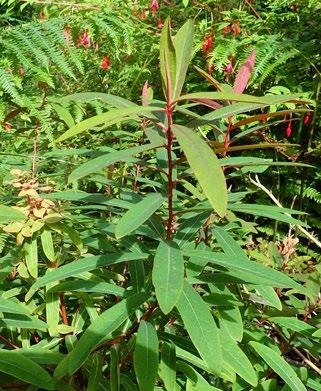
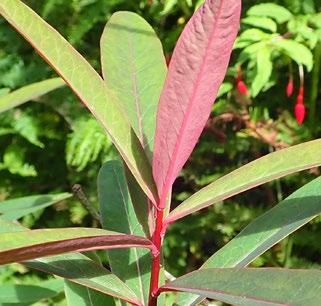
Euphorbia sikkimensis, Portree, North Ebudes (v.c. 104). Stephen Bungard
Clement, E.J., Smith, D.P.J. & Thirlwell, I.R. 2005. Illustrations of Alien Plants of the British Isles. Botanical Society of the
British Isles, London. Poland, J. & Clement, E.J. 2020. The Vegetative Key to the British
Flora (2nd edn). John Poland, Southampton. Ryves, T.B., Clement, E.J. & Foster, M.C. 1996. Alien grasses of the British Isles. Botanical Society of the British Isles,
London. Stace, C.A. 2019. New Flora of the British Isles (4th edn).
C & M Floristics, Middlewood Green, Suffolk.









